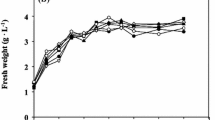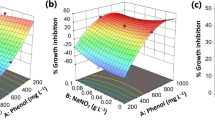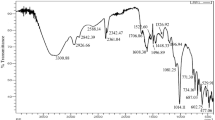Abstract
To realize the applied potentials, response surface methodology was attempted to optimize astaxanthin accumulation in a newly isolated Haematococcus lacustris (CZJ) strain from China. Analysis of the astaxanthin metabolic pathway was also conducted. The results showed that 200 ~ 500 μmol photons m−2 s−1 light intensity, 0.25 ~ 1 g L−1 sodium acetate and 3 ~ 12 mg L−1 salicylic acid can affect pigments or biomass to increase astaxanthin concentration in CZJ. These processes were regulated by corresponding enzyme activities and gene expressions. However, 1 ~ 4 g L−1 sodium chloride and 2.5 ~ 10 mg L−1 ferrous sulfate had restraining effects on astaxanthin accumulation in CZJ. Based on response surface methodology, the combined condition for optimal astaxanthin concentration was light intensity of 489 μmol photons m−2 s−1–sodium acetate concentration of 1 g L−1 salicylic acid concentration of 10 mg L−1. Under this optimized condition, the astaxanthin concentration increased to 6.50 mg L−1. These results supplemented the property of a newly isolated H. lacustris strain from China and partly improved its application potential. The superiority of response surface methodology was also verified. This study provides important references for optimizing astaxanthin accumulation in Haematococcus strains.











Similar content being viewed by others
Data availability
Data will be made available on request.
References
Addlesee HA, Gibson LC, Jensen PE, Hunter CN (1996) Cloning, sequencing and functional assignment of the chlorophyll biosynthesis gene, chlP, of Synechocystis sp. PCC 6803. FEBS Lett 389:126-l30
Beardall J, Raven JA (2016) Carbon acquisition by microalgae. In: Borowitzka MA, Beardall J, Raven JA (eds) The physiology of microalgae. Springer, Dordrecht, pp 89–99
Box GEP, Behnken DW (1960) Some new three level designs for the study of quantitative variables. Technometrics 2:455–475
Borowitzka MA, Huisman JM, Osborn A (1991) Culture of the astaxanthin-producing green alga Haematococcus pluvialis 1. Effects of nutrients on growth and cell type. J Appl Phycol 3:295–304
Brendler T, Williamson EM (2019) Astaxanthin: how much is too much? a safety review. Phytother Res 33:1–22
Czerpak R, Bajguz A, Gromek M, Kozlowska G, Nowak I (2002) Activity of salicylic acid on the growth and biochemism of Chlorella vulgaris Beijerinck. Acta Physiol Plant 24:45–52
Chekanov K, Lobakova E, Selyakh I, Semenova L, Sidorov R, Solovchenko A (2014) Accumulation of astaxanthin by a new Haematococcus pluvialis strain bm1 from the white sea coastal rocks Russia. Mar Drugs 12:4504–4520
Cui DD, Yang L, Sun X, Zou ZM, Xu NJ (2018) Effects of zeatin and salicylic acid on growth and astaxanthin accumulation in Haematococcus pluvialis. Oceanol Limnol Sin 49:682–691
Dai Y, Mu L, Huang X (2023) Optimization of culture conditions for a newly isolated microalga Haematococcus pluvialis. J Shanghai Ocean Univ 32:68–78
Fan G, Cheng L, Fu Z, Sun B, Teng C, Jiang X, Li X (2020) Screening of yeasts isolated from Baijiu environments for 2-phenylethanol production and optimization of production conditions. 3 Biotech 10:275
Gao Z, Meng C, Chen YC, Ahmed F, Mangott A, Schenk PM (2015) Comparison of astaxanthin accumulation and biosynthesis gene expression of three Haematococcus pluvialis strains upon salinity stress. J Appl Phycol 27:1853–1860
Gao Z, Meng C, Zhang X, Xu D, Miao X, Wang Y, Yang L, Lv H, Chen L, Ye N (2012) Induction of salicylic acid SA on transcriptional expression of eight carotenoid genes and astaxanthin accumulation in Haematococcus pluvialis. Enzyme Microb Technol 51:225–230
Gilannejad N, Martínez-Rodríguez G, Yúfera M, Moyano FJ (2017) Estimating the effect of different factors on the digestive bioaccessibility of protein by the Senegalese sole (Solea senegalensis); combination of response surface methodology and in vitro assays. Aquaculture 477:28–34
Göksan TAk, Şevket G (2010) An alternative approach to the traditional mixotrophic cultures of Haematococcus pluvialis Flotow (Chlorophyceae). J Microbiol Biotechnol 20:1276-1282
Gunst RF, Myers RH, Montgomery DC (1996) Response surface methodology: process and product optimization using designed experiments. Technometrics 38:284–286
Han D, Li Y, Hu Q (2013) Astaxanthin in microalgae: pathways, functions and biotechnological implications. Algae 28:131–147
Harper JE, Paulsen GM (1968) Influence of intensity, quality, and duration of light on nitrogen reduction and assimilation in wheat. Crop Sci 8:537–539
Harker M, Tsavalos AJ, Young AJ (1996) Factors responsible for astaxanthin formation in the chlorophyte Haematococcus pluvialis. Bioresour Technol 55:207–214
He B, Hou L, Dong M, Shi J, Huang X, Ding Y, Cong X, Zhang F, Zhang X, Zang X (2018) Transcriptome analysis in Haematococcus pluvialis: astaxanthin induction by high light with acetate and Fe2+. Int J Mol Sci 19:175
Hernández Morales KJ, Pérez Morales ME, Romo CJ, Jurado AA, Ayala LAH (2015) Production conditions of astaxanthin by Haematococcus pluvialis: Literature review 2003–2013. Rev Mex Cienc Farm 46:7–16
Hong ME, Choi YY, Sang JS (2016) Effect of red cyst cell inoculation and iron(II) supplementation on autotrophic astaxanthin production by Haematococcus pluvialis under outdoor summer conditions. J Biotechnol 218:25–33
Hu C, Cui D, Sun X, Shi J, Xu N (2020) Primary metabolism is associated with the astaxanthin biosynthesis in the green algae Haematococcus pluvialis under light stress. Algal Res 46:101768
Huang JC, Chen F, Sandmann G (2006) Stress-related differential expression of multiple β-carotene ketolase genes in the unicellular green alga Haematococcus pluvialis. J Biotechnol 122:176–185
Huang X, Huang Z, Wen W, Yan J (2013) Effects of nitrogen supplementation of the culture medium on the growth, total lipid content and fatty acid profiles of three microalgae Tetraselmis subcordiformis, Nannochloropsis oculata and Pavlova viridis. J Appl Phycol 25:129–137
Huiru Z, Bilian C, Mingzi W, Haisheng LU, Qiaoqin S (2000) Mixotrophic and heterotrophic growth of Haematococcus pluvialis. Microbiology 27:198–201 (in Chinese)
Jeon YC, Cho CW, Yun YS (2005) Combined effects of light intensity and acetate concentration on the growth of unicellular microalga Haematococcus pluvialis. Enzyme Microb Technol 39:490–495
Ji HK, Affan A, Jang J, Kang MH, Kang DH (2015) Morphological, molecular, and biochemical characterization of astaxanthin-producing green microalgae Haematococcus sp. KORDI03 (Haematococcaceae, Chlorophyta) isolated from Korea. J Microbiol Biotechnol 25:238–246
Kobayashi M, Kakizono T, Nagai S (1991) Astaxanthin production by a green alga, Haematococcus pluvialis accompanied with morphological changes in acetate media. J Ferment Bioeng 71:335–339
Kobayashi M, Kakizono T, Nagai S (1993) Enhanced carotenoid biosynthesis by oxidative stress in acetate-induced cyst cells of a green unicellular alga, Haematococcus pluvialis. Appl Environ Microbiol 59:867–873
Kocabaş Z (2001) An Application and interpretation of second order response surface model. Ankara Üniversitesi Tarım Bilimleri Dergisi (J Agric Sci) 7:121–128
Kovalev N, Leskova SE, Mikheev EV, Esipenko R (2021) Influence of salicylic acid on production characteristics and biochemical parameters of Tetraselmis suecica in enrichment culture. Vestn Astrakhan Satete Tech Univ Ser: Fishing Indust 2021:90–99
Li W, Bai H, Zhao H (2021) Study on the conditions optimization for astaxanthin accumulation in Haematococcus pluvialis. Food Res Dev 42:152–156
Le-Feuvre R, Moraga-Suazo P, Gonzalez J, Martin SS, Henríquez V, Donoso A, Agurto-Muñoz C (2020) Biotechnology applied to Haematococcus pluvialis Fotow: challenges and prospects for the enhancement of astaxanthin accumulation. J Appl Phycol 32:3831–3852
Li X, Wang X, Duan C, Yi S, Li J (2020) Biotechnological production of astaxanthin from the microalga Haematococcus pluvialis. Biotechnol Adv 43:107602
Liu X, Duan S, Li A, Xu N, Cai Z, Hu Z (2009) Effects of organic carbon sources on growth, photosynthesis, and respiration of Phaeodactylum tricornutum. J Appl Phycol 21:239–246
Liufu W, Di M, Yingying P, Liqiu S, Wenzhi W (2023) Nitrogen limitation and hydrogen peroxide act synergistically to enhance lipids accumulation via ROS/Ca2+ dependent mechanism in Chlorella sorokiniana. Algal Res 70:102974
Liu D, Kong DD, Fu XK, Ali B, Xu L, Zhou WJ (2016) Influence of exogenous 5-aminolevulinic acid on chlorophyll synthesis and related gene expression in oilseed rape de-etiolated cotyledons under water-deficit stress. Photosynthetica 54:468–474
Lu Z, Dai J, Zheng L, Teng Z, Zhang Q, Qiu D, Song L (2020) Disodium 2-oxoglutarate promotes carbon flux into astaxanthin and fatty acid biosynthesis pathways in Haematococcus. Bioresour Technol 299:122612
Ma R, Thomas-Hall SR, Chua ET, Alsenani F, Eltanahy E, Netzel ME, Netzel G, Lu Y, Schenk PM (2018) Gene expression profiling of astaxanthin and fatty acid pathways in Haematococcus pluvialis in response to different LED lighting conditions. Bioresour Technol 250:591–602
Minmin S (2016) Investigation on the effect and their mechanism of different induction condition on astaxanthin production in Haematococcus pluvialis LUGU. M.D. Thesis, Kunming University of Science and Technology. Kunming, China. 108 p
Mirshekari M, Einali A, Valizadeh J (2019) Metabolic changes and activity pattern of antioxidant enzymes induced by salicylic acid treatment in green microalga Dunaliella salina under nitrogen deficiency. J Appl Phycol 31:1709–1719
Mostafa N, Omar H, Tan SG, Napis S (2011) Studies on the genetic variation of the green unicellular alga Haematococcus pluvialis (Chlorophyceae) obtained from different geographical locations using ISSR and RAPD molecular marker. Molecules 16:2598–2608
Myers RH, Montgomery DC (2002) Response Surface Methodology Process and Product Optimization Using Designed Experiments. Wiley, NY
Orosa M, Franqueira D, Cid A, Abalde J (2005) Analysis and enhancement of astaxanthin accumulation in Haematococcus pluvialis. Bioresour Technol 96:373–378
Ping H, Duncan J, Barber J (2007) Astaxanthin accumulation in the green alga Haematococcus pluvialis: effects of cultivation parameters. J Integr Plant Biol 49:447–451
Pospíšil P (2012) Molecular mechanisms of production and scavenging of reactive oxygen species by photosystem II. Biochim Biophys Acta Bioenerg 1817:218–231
Raman V, Ravi S (2011) Effect of salicylic acid and methyl jasmonate on antioxidant systems of Haematococcus pluvialis. Acta Physiol Plant 33:1043–1049
Ravishankar GA, Rao AR (eds) (2021) Global Perspectives on Astaxanthin: From Industrial Production to Food, Health, and Pharmaceutical Applications. Academic Press, London
Ren Y, Deng J, Huang J, Wu Z, Yi L, Bi Y, Chen F (2021) Using green alga Haematococcus pluvialis for astaxanthin and lipid co-production: Advances and outlook. Bioresour Technol 340:125736
Sarada R, Tripathi U, Ravishankar GA (2002) Influence of stress on astaxanthin production in Haematococcus pluvialis grown under different culture conditions. Process Biochem 37:623–627
Soto-Ramírez R, Tavernini L, Zúñiga H, Poirrier P, Chamy R (2021) Study of microalgal behaviour in continuous culture using photosynthetic rate curves: The case of chlorophyll and carotenoid production by Chlorella vulgaris. Aquacult Res 52:3639–3648
Steinbrenner J, Linden H (2003) Light induction of carotenoid biosynthesis genes in the green alga Haematococcus pluvialis: regulation by photosynthetic redox control. Plant Mol Biol 52:343–356
Sun Z, Gantt CE (1998) Differential expression of two isopentenyl pyrophosphate isomerases and enhanced carotenoid accumulation in a unicellular chlorophyte. Proc Nat Acad Sci 95:14585–14585
Wang F, Gao B, Wu M, Huang L, Zhang C (2019a) A novel strategy for the hyper-production of astaxanthin from the newly isolated microalgae Haematococcus pluvialis JNU35. Algal Res 39:101466
Wang L, Zhuang H, Zhang Y, Wei W (2019b) Diversity of the Bosmina (Cladocera: Bosminidae) in China, revealed by analysis of two genetic markers (mtDNA 16S and a nuclear ITS). BMC Evol Biol 19:145
Zhang WW, Zhou XF, Zhang YL, Cheng PF, Ma R, Cheng WL, Chu HQ (2018) Enhancing astaxanthin accumulation in Haematococcus pluvialis by coupled light intensity and nitrogen starvation in column photobioreactors. J Microbiol Biotechnol 28:2019–2028
Zhao Y, Shang M, Xu JW, Zhao P, Li T, Yu X (2015) Enhanced astaxanthin production from a novel strain of Haematococcus pluvialis using fulvic acid. Process Biochem 50:2072–2077
Zhao Z, Sun D, Mao X, Jin L, Feng C (2016) The crosstalk between astaxanthin, fatty acids and reactive oxygen species in heterotrophic Chlorella zofingiensis. Algal Res 19:178–183
Zhao Y, Cui J, Li Q, Qiao T, Zhong DB, Zhao P, Yu X (2021) A joint strategy comprising melatonin and 3-methyladenine to concurrently stimulate biomass and astaxanthin hyperaccumulation by Haematococcus pluvialis. Bioresour Technol 341:125784
Zi-Nan LI, Chen XQ, Ren JW, Jing-Jing HE, Zhang XH (2016) The effect of sodium nitrate and salicylic acid on astaxanthin accumulation of alga Haematococcus pluvialis. Chin Food Addit 8:131–134
Acknowledgements
Xu Caiqin is kind for providing us language modification in this paper.
Funding
This project is supported by supported by the project of Shanghai Municipal Agricultural Commission (2021–02-08–00-12-F00761).
Author information
Authors and Affiliations
Contributions
Liufu Wang: Investigation, Visualization. Ying Dai: Investigation, Data curation, Methodology. Liufu Wang and Ying Dai: Data curation, Formal analysis, Validation, Writing-original draft, Writing-review & editing. Xuxiong Huang: Resources, Supervision, Funding acquisition, Conceptualization, Project administration.
Corresponding author
Ethics declarations
Competing interests
The authors declare no competing interests.
Additional information
Publisher's Note
Springer Nature remains neutral with regard to jurisdictional claims in published maps and institutional affiliations.
Liufu Wang, Ying Dai Co-first author, these authors contributed equally to this work and share first authorship.
Supplementary Information
Below is the link to the electronic supplementary material.
Rights and permissions
Springer Nature or its licensor (e.g. a society or other partner) holds exclusive rights to this article under a publishing agreement with the author(s) or other rightsholder(s); author self-archiving of the accepted manuscript version of this article is solely governed by the terms of such publishing agreement and applicable law.
About this article
Cite this article
Wang, L., Dai, Y. & Huang, X. Optimization of astaxanthin accumulation in a new Haematococcus lacustris (CZJ) strain from China via response surface methodology. J Appl Phycol 36, 15–28 (2024). https://doi.org/10.1007/s10811-023-03117-6
Received:
Revised:
Accepted:
Published:
Issue Date:
DOI: https://doi.org/10.1007/s10811-023-03117-6




